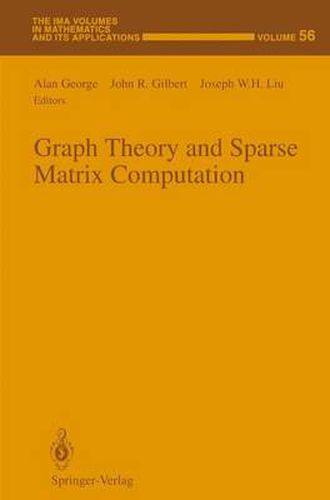Readings Newsletter
Become a Readings Member to make your shopping experience even easier.
Sign in or sign up for free!
You’re not far away from qualifying for FREE standard shipping within Australia
You’ve qualified for FREE standard shipping within Australia
The cart is loading…






This title is printed to order. This book may have been self-published. If so, we cannot guarantee the quality of the content. In the main most books will have gone through the editing process however some may not. We therefore suggest that you be aware of this before ordering this book. If in doubt check either the author or publisher’s details as we are unable to accept any returns unless they are faulty. Please contact us if you have any questions.
This IMA Volume in Mathematics and its Appllcations GRAPH THEORY AND SPARSE MATRIX COMPUTATION is based on the proceedings of a workshop that was an integraI part of the 1991- 92 IMA program on Applied Linear AIgebra. The purpose of the workshop was to bring together people who work in sparse matrix computation with those who conduct research in applied graph theory and grl:l,ph algorithms, in order to foster active cross-fertilization. We are grateful to Richard Brualdi, George Cybenko, Alan Geo~ge, Gene Golub, Mitchell Luskin, and Paul Van Dooren for planning and implementing the year-Iong program. We espeeially thank Alan George, John R. Gilbert, and Joseph W.H. Liu for organizing this workshop and editing the proceedings. The finaneial support of the National Science Foundation made the workshop possible. A vner Friedman Willard Miller. Jr. PREFACE When reality is modeled by computation, linear algebra is often the con nec- tiori between the continuous physical world and the finite algorithmic one. Usually, the more detailed the model, the bigger the matrix, the better the answer. Efficiency demands that every possible advantage be exploited: sparse structure, advanced com- puter architectures, efficient algorithms. Therefore sparse matrix computation knits together threads from linear algebra, parallei computing, data struetures, geometry, and both numerieal and discrete algorithms.
$9.00 standard shipping within Australia
FREE standard shipping within Australia for orders over $100.00
Express & International shipping calculated at checkout
This title is printed to order. This book may have been self-published. If so, we cannot guarantee the quality of the content. In the main most books will have gone through the editing process however some may not. We therefore suggest that you be aware of this before ordering this book. If in doubt check either the author or publisher’s details as we are unable to accept any returns unless they are faulty. Please contact us if you have any questions.
This IMA Volume in Mathematics and its Appllcations GRAPH THEORY AND SPARSE MATRIX COMPUTATION is based on the proceedings of a workshop that was an integraI part of the 1991- 92 IMA program on Applied Linear AIgebra. The purpose of the workshop was to bring together people who work in sparse matrix computation with those who conduct research in applied graph theory and grl:l,ph algorithms, in order to foster active cross-fertilization. We are grateful to Richard Brualdi, George Cybenko, Alan Geo~ge, Gene Golub, Mitchell Luskin, and Paul Van Dooren for planning and implementing the year-Iong program. We espeeially thank Alan George, John R. Gilbert, and Joseph W.H. Liu for organizing this workshop and editing the proceedings. The finaneial support of the National Science Foundation made the workshop possible. A vner Friedman Willard Miller. Jr. PREFACE When reality is modeled by computation, linear algebra is often the con nec- tiori between the continuous physical world and the finite algorithmic one. Usually, the more detailed the model, the bigger the matrix, the better the answer. Efficiency demands that every possible advantage be exploited: sparse structure, advanced com- puter architectures, efficient algorithms. Therefore sparse matrix computation knits together threads from linear algebra, parallei computing, data struetures, geometry, and both numerieal and discrete algorithms.